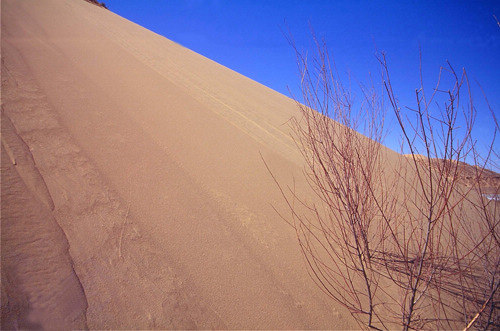|
 |
|
MOUNTAINS OF SAND: The photo shows tamarisks planted on the edge of the Maowusu Desert in Yulin City, Shaanxi Province, to prevent desertification (WU LUMING) |
A biomass thermoelectric project's successes in combating desertification in China's Maowusu Desert drew much attention at the Third Intersessional Meeting of the United Nations Conference on Sustainable Development (UNCSD) on March 26.
Scientists from China introduced their efforts to combat desertification, reduce carbon emissions and improve people's livelihoods at a side event concerning the sustainable development of Inner Mongolia. The symposium was cosponsored by China's State Forestry Administration, the Government of Inner Mongolia Autonomous Region, and Inner Mongolian Maowusu Biomass Thermoelectric Co.
"The Chinese Government has made outstanding achievements over the past several years by means of planting trees, with the Maowusu project as one of the successful cases," said Sha Zukang, UN Undersecretary General for Economic and Social Affairs, and Secretary General of Rio+20 of the UNCSD. "The project made great efforts in dealing with global climate change, shouldering social responsibility and developing green economy, and its experiences are worth learning from," added Sha.
French botanist Andre Aubréville coined the term "desertification" to describe the process by which fertile land becomes desert. Since the 1990s, the issue has drawn attention from scientists and the governments of many countries. The UN has convened many special conferences to discuss methods of preventing this form of land degradation, which is often caused by inappropriate agricultural methods, overgrazing, climate change and soil erosion.
In 1992, the UN Earth Summit was held in Rio de Janeiro, where representatives of countries worldwide discussed specific ways to implement sustainable development. One of the outcomes of that summit was the adoption of Agenda 21, the UN action plan for the 21st century. It is a comprehensive blueprint of action to be taken globally, nationally, and locally by the UN, governments, and major organizations in every area in which humans directly affect the environment.
In October 1994, representatives of countries in the world adopted United Nations Convention to Combat Desertification. In the convention, desertification was defined as "land degradation in arid, semi-arid and dry sub-humid areas resulting from various factors, including climatic variations and human activities."
Currently, one third of the world's landmass are threatened by desertification, resulting in an increasingly austere impact on society, economy and environment. Many countries list desertification and land degradation as a challenge to long-term social and economic development.
China has the largest area of land affected or threatened by desertification in the world according to the State Forestry Administration. By the end of 2009, the country had 2.62 million square km of degraded or degrading land, and 1.73 million square km of desertified land, as well as 310,000 square km land showing an apparent tendency toward desertification.
There has long been a dispute on methods to combat desertification and relations between desertification control and sustainable development.
A surprisingly large portion of sandy areas in the world contain water, and only 50 cm beneath the surface of most deserts, the humidity content is around 5 percent. Far from being dead wastelands, desert ecosystems typically contain enough water to support plant growth.
"Planting trees is a common method to fight against desertification," said Li Jinglu, General Manager of the Maowusu Biomass Thermoelectric Co. However, maintaining the shrubs requires significant investments, a big challenge, as shrubs need constant cutting to survive, according to Li.
| 